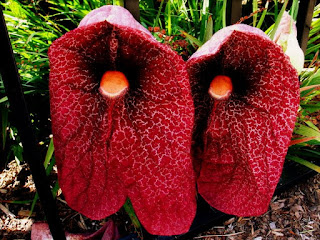
It's berry time again! The onset of cooler autumn weather and the changing of the leaves always reminds me how important berries are in the garden. Plants with berries help to extend the season of interest well into winter in most places. Most berry-producing plants are trees or shrubs of some kind and I thought I'd run through a short list of some favorites. (This is not an exhaustive, all-inclusive list--just a little something to whet your appetite.)
One of my all-time favorite berry plants is our southeastern native beautyberry, Callicarpa americana. It's royal purple berries begin to color up in September while the leaves are still hanging tight. Then, in October, the foliage turns brilliant yellow with the purple berries hugging the stems of the plant. The berries continue to hang on until well after the foliage drops and will retain their brilliant purple color until the weather really gets cold and we have a few hard freezes--often late November to early December--so that gives you an extra two months of color. One of my favorite combinations in the garden is American beautyberry with oakleaf hydrangea. I have several gardens where we have used this combination to great effect, particularly the dwarf oakleaf hydrangea called 'Peewee' whose deep maroon fall color is stunning with the purple American beautyberry. The only drawback is that Callicarpa americana is a pretty strong Zone 6b plant. Much colder than that and it may or may not make it through the winter.
Another favorite berry plant for the winter months is, of course, Ilex verticillata. There are a number of these on the market, but my favorite is probably the cultivar 'Red Sprite'. It's compact enough at 4 feet tall to fit into almost any landscape and the berries are at least twice the size of almost any other "winterberry"-type holly out there. I say "winterberry"-type because 'Winterberry' is actually a cultivar, but it has come into play in the industry as a common name, too, so a rather rash generalization is in play here. Being a non-conformist, I'm trying to stay out of that trap. Don't forget, with deciduous hollies (and evergreen ones, too, for that matter), male and female are needed for berry production. If you choose to grow 'Red Sprite', make sure that you plant 'Jim Dandy' nearby in order to ensure copious quantities of berries every fall and winter.
In the realm of small trees, crabapples are obviously unsurpassed for their production of beautiful small fruits in late summer and fall, many of which will hang on well into the winter if the birds (and deer) don't strip them clean. 'Red Jade' is one of the best and is perfect for the smaller landscape because of its "weeping" habit and small size--only 8 to 10 feet at maturity. It's stunning floral show in the spring is only a harbinger of things to come in the fall when it dazzles in the landscape with brilliant red fruits. 'Red Jewel' is another excellent choice when it comes to crabapples. Again, a slightly more compact tree, topping out at only 10-15 feet which makes it a great choice for today's smaller yards. White blossoms in spring and abundant cherry red fruits that persist well into winter make it a favorite "bird" tree when other sources of late autumn food have been used up.
In standard-size crabapples 'Sugar Tyme' is the way to go! It is second-to-none when it comes to fall and winter fruit display and its disease resistance makes for a great-looking plant throughout the growing season with few of the common crabapple problems. At 15 to 18 feet tall, it's still a great size for smaller yards, but is also able to hold its own in the larger landscape. Another excellent disease resistant selection is 'Donald Wyman', providing a great show of white blooms in the spring and branches full of brilliant red fruits in autumn and winter.
Of course, there are scads of other berry-producers that look great in the fall and winter landscape, but these are just a few favorites to whet your appetite. Enjoy!








